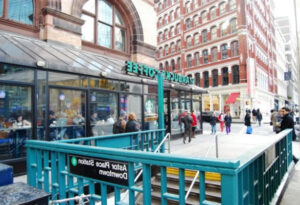When walking into the Starbucks on Astor Place, everything seems normal. With the brown and green color scheme, coffee-stained countertops, customers clustered around the pick-up area. Yet, something about the barista seems off: attached to their apron, there is a pin resembling the company’s logo, showing a firm fist gripping a cocktail shaker with the words “Starbucks Workers United.” The reality is that this Starbucks is one out of over 190 that have been unionized among 1500 stores in the US. And this movement goes beyond just Starbucks stores in New York.
Image by Greenwichvillage.nyc.
The Firm Fist of the Astor Place Starbucks
The unionization of the Astor Place Starbucks is part of a resurging labor movement in the US, thanks to the efforts of young adults in the service industry. Companies such as Starbucks and Amazon have garnered the most attention regarding upticks in union elections. In both instances, New York has been the birthplace of the movement. In April 2022, Amazon warehouse workers in Staten Island voted and became the company’s first National Labor Relations Board (NLRB) recognized union. Similarly, a Starbucks in Buffalo became the first to win their union election in late 2021.
On April 29th, 2022, Starbucks workers at the Astor Place location voted to unionize 11-2 – they became the 41st store to win their election. The movement gathered significant media attention and now appears to be contagious. Rhythm Heaton, an employee at the Astor Place Starbucks, explained that the decision to unionize came after witnessing the original Buffalo store win their election. “It wasn’t until I found out about Buffalo that I started trying to unionize [Astor Place], and the rest is history.”
Image by Left Voice.
But the campaign was not without its challenges. Heaton described the excitement of organizing with his co-workers despite the difficulties of “getting people on the same page” regarding certain unionization myths that surfaced during the election. Another employee, Chloe Madrid, got involved with the movement motivated by her desire for better pay. She had limited knowledge about unions until the election.
Still, she was a long-time employee who knew the company culture well, “Once I started meeting union reps, and learning the whole process, now I understand it, and I’m teaching people, but beforehand, I knew nothing.” She acknowledged the process was intense, and the company’s tactics were intimidating at times, especially to less experienced co-workers who feared losing benefits along the way. However, these elections have undoubtedly proven to be an educational opportunity for these service workers.
A Typical Corporate Response but A Supportive Customer Base
Corporations such as Starbucks have garnered notoriety for utilizing union-busting tactics. CEO Howard Schultz has stated that he does not plan to engage with the Workers United union. Employees claim that the company has begun a campaign of withholding certain benefits to disincentivize others from unionizing. Managers have told them that certain benefits, such as transgender-inclusive healthcare, could disappear if they unionize. Days before the overturning of Roe v. Wade and the prospect of abortion being illegal in certain states, acting executive vice president Sara Kelly stated that Starbucks would offer “medical travel reimbursement” to employees but could not guarantee the same benefits for unionized employees.
Schultz believes that “the customer experience will be significantly challenged and less than if a third party is integrated into our business.” However, workers at the Astor Place location tell a different story. One employee, Edwin Palma Soils, stated that customers supported the union drive: “The customers would change their name in the Starbucks app to ‘Union Yes’ or anything that would support the drive.”
The REI Workers’ Strategic Campaign
Just 10 minutes from the Astor Place Starbucks lies the only REI Co-Op store in New York City, which also happened to unionize this year. The SoHo store became the first REI and consumer cooperative to unionize in the US. REI portrays itself as a progressive company to the public. It cynically utilizes that image in its union-busting strategies, most notably producing a podcast with anti-union undertones that opens with a land acknowledgment. REI’s hardline campaign also apparently included captive audience meetings, abundant anti-union literature, and other fear tactics. Their campaign backfired as it quickly galvanized employees in support of the union.
REI workers such as Steve Buckley, who comes from a union family, grew frustrated at the lack of support from the company during the coronavirus pandemic. He mentioned that organizers were secretive during the preparation phase and turned vocal once the filing became public. Throughout the election, customers were supportive, including by criticizing the company on their social media posts. Unionization has brought him hope that specific labor demands such as stable hours and additional benefits will be met. It is still too early to tell the impact of the newly formed unions.
Still, Buckley was looking forward to starting the bargaining phase saying, “I’m incredibly excited to find the answers to these questions [hours and benefits] in a democratic way that will have input from my colleagues and those who are impacted.” Like the Starbucks union victory in Buffalo, the success of the New York City REI union election has sent a message to other REI stores. At least one store in Berkeley, California, has now started its union election.
A New Kind of US Union Worker
Both union elections in the Astor Place Starbucks and REI SoHo highlight a shift in what it means to be a union worker in the US. As the younger, more diverse generations begin to enter the job market, the people who make up the today’s labor unions will change accordingly. Today, 80% of the US workforce operates in the service industry, and the rise of these new industry labor unions reflects that reality. Over time, the public image of what people imagine a union worker looks like will no longer be the stereotypical hard hat and vest-wearing factory worker. It will expand to include the person behind the counter at your favorite store. These fledgling unions will need the help and guidance from the previous generations of union workers so that the labor movement can continue in the 21st century.
The coronavirus pandemic has shown that society would cease to function without these service workers. The realization of the importance of service industry workers has helped fuel this pro-union fervor. This energy is exemplified through workers’ grievances in both Starbucks and REI, as stated by Buckley “If we are expected to outfit people during a pandemic so they could survive Kilimanjaro… we deserve safe working conditions, dignity, and respect.” It is unknown the long-term impacts these two newly formed unions will bring to New York, but it’s safe to say that the city will continue to be a union town for generations to come.






